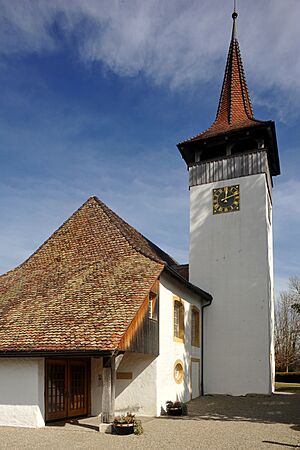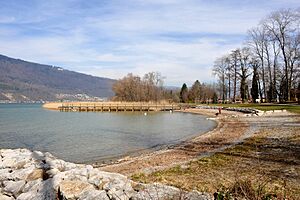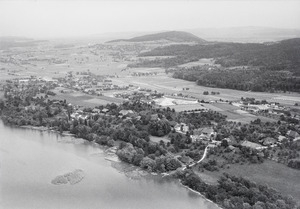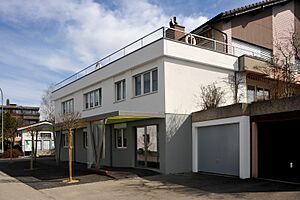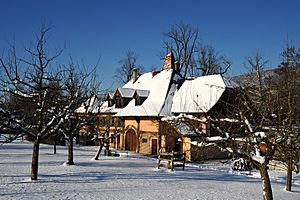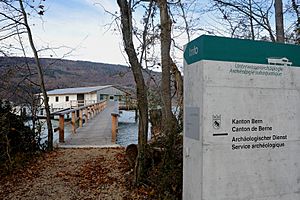Sutz-Lattrigen facts for kids
Quick facts for kids
Sutz-Lattrigen
|
||
|---|---|---|
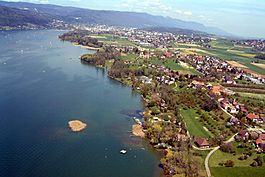
Aerial view of Sutz and Lattrigen villages
|
||
|
||
| Country | Switzerland | |
| Canton | Bern | |
| District | Biel/Bienne | |
| Area | ||
| • Total | 3.57 km2 (1.38 sq mi) | |
| Elevation | 450 m (1,480 ft) | |
| Population
(Dec 2020 )
|
||
| • Total | 1,399 | |
| • Density | 391.9/km2 (1,015.0/sq mi) | |
| Postal code |
2572
|
|
| Surrounded by | Bellmund, Hermrigen, Ipsach, Mörigen, Tüscherz-Alfermée, Twann | |
Sutz-Lattrigen is a town, also called a municipality, located in the Biel/Bienne area of the canton of Bern in Switzerland. It is famous for its very old lake shore settlements from the Neolithic (New Stone Age) and Bronze Age. One of these sites is even part of a UNESCO World Heritage Site, which means it's a place of great importance to everyone in the world.
Contents
History of Sutz-Lattrigen
Sutz-Lattrigen is located right on the shore of Lake Biel. In 2007, something amazing was found here: the remains of the oldest known building in Switzerland! It was a pile dwelling (a house built on stilts over water or wet ground) from about 3863 BC.
Later, during the Stone Age and Bronze Age, people from the Corded ware culture lived along the shoreline. In 2011, these ancient settlement remains became part of a UNESCO World Heritage Site.
The village of Sutz was first mentioned in old records in 1228. Lattrigen village was first mentioned in 1270. During the Middle Ages (a long time ago, from about 500 AD to 1500 AD), both villages belonged to the Counts of Neuchâtel-Nidau. In 1398, the city of Bern took control of the villages and the land around them.
Over the next century, different groups owned parts of the land. These included rich local families (called patricians) and religious communities (called monastic houses or Abbeys). However, in 1528, Bern changed its religion to Protestantism. This meant they took over all the land owned by the Abbeys, bringing Sutz and Lattrigen directly under Bern's control.
After the French invasion in 1798, Sutz-Lattrigen became part of a new area called the Seeland district. Later, in 1803, it became part of the Nidau district.
The church in Sutz village was first mentioned in 1228. Its old Romanesque walls show it's even older than that. The bell tower was built in 1485, and the choir (the part of the church where the singers sit) was built in 1510. This church also served people from villages across the lake until 1993.
In the 1600s, Bern built a pier (a dock for boats) and a warehouse in Lattrigen. This helped the village connect to trade routes on the lake. In 1916, the villages got a railroad connection. Sutz and Lattrigen shared a school and farmland, and over time, they grew closer and became one municipality. By the 1950s, the two villages had grown so much that they became one continuous town.
Geography of Sutz-Lattrigen
Sutz-Lattrigen covers an area of about 3.6 square kilometers. A large part of the land, about 44.2%, is used for farming. About 31.7% of the area is covered by forests. The rest of the municipality, about 21.4%, has buildings or roads. A small part, 2.5%, is rivers or lakes, and 0.6% is land that can't be used for anything.
Most of the forested land is covered with thick forests. For farming, about 33.9% of the land is used for growing crops. Another 5.0% is used for pastures where animals graze, and 5.3% is used for growing fruits or grapes.
The municipality is located on the right side of Lake Biel. It includes the two villages of Sutz and Lattrigen.
In 2010, Sutz-Lattrigen joined a new administrative area called Verwaltungskreis Biel/Bienne.
Coat of Arms
The blazon (a special description for coats of arms) of Sutz-Lattrigen's municipal coat of arms is: Gules an Anchor Argent between two Mullets Or in chief. This means it has a red background (Gules). On it, there is a silver anchor (Anchor Argent) placed between two gold stars (Mullets Or) at the top (in chief).
People of Sutz-Lattrigen (Demographics)
Sutz-Lattrigen has a population of about 1,352 people (as of December 2011). About 7.1% of the people living here are foreign nationals (people from other countries). Over the last ten years, the population has grown slightly.
Most people in Sutz-Lattrigen (about 92.4%) speak German as their main language. French is the second most common language (4.6%), followed by Spanish (0.8%).
In 2008, about 48.1% of the population was male and 51.9% was female. Most people (about 70%) were born either in Sutz-Lattrigen or somewhere else in the same canton (Bern).
Children and teenagers (ages 0-19) make up about 22.4% of the population. Adults (ages 20-64) make up 61.1%, and seniors (over 64) make up 16.5%.
In 2000, about 472 people in the municipality were single and had never been married. There were 569 married people, 60 widows or widowers, and 50 divorced people.
The chart below shows how the population of Sutz-Lattrigen has changed over time:

Important Heritage Sites
The ancient lake-side settlement from the Neolithic and Bronze Age, called Sutz-Lattrigen–Rütte, is a very important heritage site in Switzerland. The Von Rütte-Gut (an old estate or property) is also listed as a national heritage site.
World Heritage Site
Sutz-Lattrigen is home to the Sutz-Lattrigen–Rütte prehistoric pile-dwelling (or stilt house) settlement. This site is part of the Prehistoric Pile dwellings around the Alps UNESCO World Heritage Site. This means it's recognized as a place of outstanding universal value.
The Sutz-Lattrigen–Rütte site is named after the nearby Von Rütte estate. People lived here during the late Neolithic period (New Stone Age). Archeologists have found remains of several settlements and artifacts (old objects) from the time when the Corded Ware culture was developing. There are only a few Corded Ware culture sites found in Europe, and all the known settlements are in Switzerland. Also, the only "bell beaker" pottery (a type of ancient pottery) found on a western Swiss lakeside was discovered at this site.
Scientists have used a method called dendrochronology (dating by tree rings) to figure out the age of the first village at the site. It was built between 2763 and 2746 BC. Not much is known about this first village. The next settlement, which had 12 houses, was built between 2736 and 2688 BC, and again in 2627 BC. This settlement was destroyed by a fire in 2704 BC, but at least 12 new houses were built right after that.
Economy of Sutz-Lattrigen
In 2011, the unemployment rate in Sutz-Lattrigen was low, at 1.47%. This means most people who wanted jobs had them.
In 2008, there were 382 people working in the municipality. These jobs were in different areas:
- Primary Sector: 36 people worked in this sector, which includes farming. There were about 13 businesses in this area.
- Secondary Sector: 163 people worked in this sector. This includes jobs like manufacturing (making things), mining, and construction (building things). There were 12 businesses in this sector.
- Tertiary Sector: 183 people worked in this sector. This includes jobs in services, like sales, transportation, hotels, restaurants, healthcare, and education. There were 40 businesses in this sector.
Many people who live in Sutz-Lattrigen also work there. However, more people travel out of the municipality for work than those who travel in. About 23.1% of working people used public transportation to get to their jobs, and 54% used a private car.
Religion
Based on a survey from 2000, most people in Sutz-Lattrigen (about 65.1%) belonged to the Swiss Reformed Church (a Protestant church). About 15.6% were Roman Catholic. Smaller numbers of people belonged to other Christian churches, or were Muslim or Jewish. About 9.3% of the population did not belong to any church, or were agnostic (not sure about God) or atheist (do not believe in God).
Education
In Sutz-Lattrigen, many adults have completed a good level of education. About 58.8% have finished non-mandatory upper secondary education (like high school), and 22.7% have gone on to higher education at a university or a specialized college (a Fachhochschule).
The Canton of Bern has a specific school system. It starts with one year of optional Kindergarten. After that, students go to six years of Primary school. Then, they have three years of mandatory lower Secondary school, where students are grouped by their abilities. After lower Secondary, students can choose to continue their schooling or start an apprenticeship (learning a trade on the job).
During the 2011-2012 school year, 120 students attended classes in Sutz-Lattrigen. There was one kindergarten class with 24 students. The municipality also had 4 primary classes with 96 students.
In 2000, 86 students attended school in Sutz-Lattrigen. Most of them (72 students) lived and went to school in the municipality. However, 111 students who lived in Sutz-Lattrigen went to schools outside the municipality.
Images for kids
See also
 In Spanish: Sutz-Lattrigen para niños
In Spanish: Sutz-Lattrigen para niños






